Cymbidium Orchid Virus
Cymbidium Orchid Virus
Written by Joshua White from the Cymbidium Orchid Society of Victoria
Photographs supplied by Joshua White and Nado Lenkic from Springfield Orchids
In my opinion, Cymbidium orchid virus is one of the worst problems that an orchid enthusiast can face in the hobby.
Unlike pests or other diseases, which can often be treated, Cymbidium orchid virus, and there are three main viruses, are incurable – the only option is to destroy the infected plant to prevent further spread.
The viruses themselves often cause unsightly markings on the leaves (and sometimes blooms), loss of vigour and reduce (or even prevent) flowering. Commercial growers also need to ensure they control Cymbidium orchid virus, as an infected mother plant can result in the loss of an entire clonal run or damage to the business’ reputation.
Prevention is the best approach
The risk from Cymbidium orchid virus can be drastically reduced with some straightforward hygiene practices. Even if you don’t think you have any plants with a Cymbidium orchid virus, it is still worth implementing these measures, as infected plants can be asymptomatic (i.e. they have no leaf or bloom markings to suggest a viral infection). Most growers will have encountered infected plants during their time in the hobby and a significant percentage will have virused plants present in their collection, whether backyard or nursery.
This article has been broken up into the following sections for ease of reading:
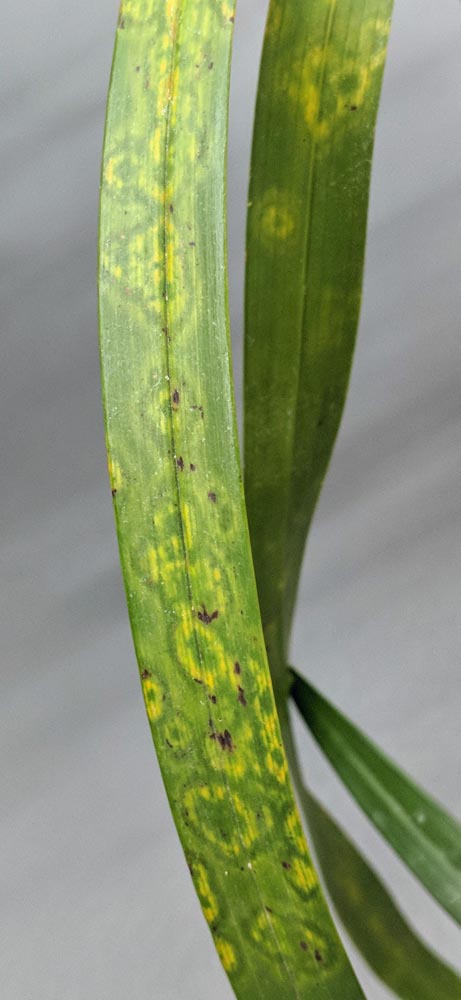
How to Prevent the Spread of Cymbidium Orchid Virus
There are some simple measures that everyone, from the backyard enthusiast to the commercial grower, can implement to help reduce the spread of Cymbidium orchid virus in their collections. They are summarised as follows:
Always clean your tools between plants.
Do not reuse pots without thoroughly cleaning them first. If you suspect a plant is infected or it tests positive, discard the pot.
Do not reuse stakes and clips for different plants (especially bamboo or timber ones, as these cannot be adequately disinfected).
Wash your hands thoroughly with soap or change your gloves between plants.
Don’t splash water between plants or let water drip from one plant onto another.
Never reuse media for other Orchids.
Maintain good pest control – the false spider mite (Brevipalpus californicus) and Australian cockroach (Periplaneta australasiae) have been shown to transfer viruses.
There are three main viruses that a Cymbidium enthusiast will usually encounter: Cymbidium Mosaic Virus (CymMV), Odontoglossum Ringspot Virus (ORSV) and Orchid Fleck Virus (OFV). Each of these will be covered in more detail in this article.
Stopping Viruses Getting Into Your Collection
Source Plants from Reputable Sellers
Ideally, you want to avoid introducing plants infected with Cymbidium orchid virus into your collection to start with. Try to source plants from orchid nurseries with good reputations; since their main focus is growing orchids, they will be more aware of the various diseases and viruses that can be present. I recommend avoiding unnamed or unlabelled plants (sometimes called NOIDs for “No Identification”) from Gumtree, eBay or local markets, as unfortunately these have a higher risk of being virused.
If you decide to source a plant from a market or online trading site such as Gumtree or eBay, check their feedback (if possible) to see what the comments are like from previous sales. Never bid on or buy a plant on eBay/Gumtree sight unseen; check the photos or ask for some if none are available. Look closely at the foliage for any signs of pests, pest damage or Cymbidium orchid virus symptoms (examples of these will be covered later). If there are any questionable markings, be aware of the possibility that it will host a Cymbidium orchid virus. You will need to weigh up the cost of having it tested against how much you want that particular plant. Personally, I have occasionally taken this risk when I was keen to get a particular plant; sometimes they were virused, sometimes not.
Quarantine New Acquisitions
When acquiring new plants, it is good practice to keep them separate from your existing collection for a while. Having designated areas to keep batches of plants quarantined is helpful; if you regularly order from multiple suppliers, it is a good idea to keep the different suppliers’ plants separated until you are satisfied with their health.
Any new acquisition should be checked for Cymbidium orchid virus and treated for pests, especially since these can spread viruses (if present) to the rest of your collection. My own approach depends on the source of the plants; if I know (or suspect) that the supplier has had a particular virus in their collection, I keep those plants isolated for the incubation period of that virus and then test them. Otherwise, I test plants from each new supplier soon after I obtain them to gain an idea of how well they control viruses in their collection. I recommend testing historical plants (i.e. those from old collections) regardless of the source, as the risk of a plant being infected goes up with the age of the plant.
Stopping Cymbidium Orchid Virus Spreading in Your Collection
Keep Plants in Groups
I’m sure most people understand the problem of having more plants than available space. Ideally every orchid would be spaced far enough apart that they weren’t touching; in reality this is often impossible to achieve or, for commercial growers, not a cost-effective use of space. I suggest an alternative approach: keeping plants in groups. When I introduce plants into my main collection, I tend to group them by supplier and/or order. That means if a virused plant is later identified from a particular order, I only have to be concerned about that particular tray of plants; I haven’t increased the risk of widespread infection by scattering all the plants from that order throughout my collection.
It also helps not to rearrange or move plants around too often. If you keep them in the same place, then only those in the immediate vicinity are likely to be affected by Cymbidium orchid virus, if another is. If you do move plants around, though, remember to disinfect the bench where it was sitting as a precautionary measure. As an aside, benches should be metal mesh (preferably in removable segments) that can be easily disinfected. Timber and other porous materials are unsuitable for benches, as not only can they trap virus particles in the material itself, but they are hard to suitably disinfect without damaging them.
Sterilize Your Tools
The most reliable way to sterilise tools between plants is to wipe them with a disposable rag or paper towel soaked in isopropyl alcohol, then flame them until the tool starts to heat up (both the AOS and OSCOV recommend this approach). You need to remove the debris and sap from the tool and get the surface above 130°C to ensure inactivation of any virus (a small butane torch, such as the one pictured and available from hardware stores, is ideal for this task). The unfortunate trade-off is that this can affect the heat treatment of blades and dull them over time.
Beyond the above, there are a variety of approaches and recipes online for disinfecting tools and pots. One approach suggested by the AOS is to soak tools in a saturated solution of trisodium phosphate (TSP, available in Australia as Tricleanium) for at least 5 minutes (personally I allow at least 15 minutes). Hu (1994) notes that a 1% solution of NaOH (sodium hydroxide) is also effective, but unfortunately does not state the timeframe required.

Pots
Ceramic pots, due to their porous nature, need to be baked in an oven for at least an hour at 130°C. Often it is necessary to soak and wash them first in order to remove any traces of media or roots that may have gotten stuck to the sides. Care must be taken to allow them to dry out before baking lest the pot crack in the process. Plastic pots are more straightforward to clean; wash them in warm, soapy water (I recommend having a set of gloves and brush specifically set aside for this purpose) to ensure all debris is removed from the pot.
The AOS then recommends soaking in a bleach solution (approx. 1 litre of household bleach to 16 litres of water) for at least 30 minutes; other sources, such as Critter Creek Lab, recommend stronger mixes (1 litre of household bleach to 10 litres of water) for an hour. One grower I know even soaks their pots overnight, using a lid over their trough to prevent the chlorine evaporating out of the bleach solution, whilst another does it as a weekly cycle.
My preference (and recommendation) is to rinse the pot thoroughly after bleaching in order to remove any residue (i.e. salt build-up). Some growers simply allow the pots or tools to air dry and have not reported any issues from this approach.
It is also worth noting that reusing pots may not be economically viable for commercial operations or large collections due to the time (labour) and materials cost involved in cleaning and disinfecting the pots. It is up to the grower to decide which approach is more cost-effective and environmentally friendly (disposal of pots vs. use of chemicals) for their particular situation.
Dispose of Old Media
Never reuse media for other Orchids. Apart from the fact that it usually breaks down with time, it will be thoroughly contaminated if the plant is virused. Depending on the media, you may be able to use it as a compost dressing in your garden. If you do reuse it in this way, any orchidaceous material should be removed and the media left to sit for a day or so to ensure any OFV present is no longer viable, as other plants can be a host for OFV as well (more on this later).
Testing for Cymbidium Orchid Virus
Testing is a useful tool in preventing the introduction or spread of Cymbidium orchid virus in your collection; it is also the only way to confirm that a plant in your collection is infected. So how do you go about getting plants tested and should you test everything?
Targeted Testing
Hobbyists and enthusiasts with only small collections may find it possible to test every plant in their collection and thereby ensure that they don’t have any virused plants. For those with larger collections or commercial growers, however, this can be an expensive and time-consuming process. Instead, they can take advantage of a form of statistics called population sampling – the selection of a smaller number of plants that will provide a reasonable indication of the condition of the whole collection.
The key is to ensure that the subset of plants used accurately represents the whole collection; this is the hardest part of the process. Look for ways in which the collection is naturally grouped – for example, by age, supplier and genetic makeup. If half your collection are historical plants that have been inherited, then half of the plants you select for testing should fall into that category. If a third are from a certain supplier or lab, then a third of the plants to be tested should be from that supplier or lab. Additionally, try to select plants at random within each of the groups to remove any bias.
The actual number of plants you will need to test depends on the size of the collection and how confident you need to be that the results accurately represent the whole collection. There are a number of online calculators for determining a statistically significant sample size; for example, if you have 1000 plants and want to know roughly what percentage are virused with 95% confidence, you would only test 278 plants.
It is also important to test any plants that have been selected for breeding or cloning. It is thought that one of the key reasons OFV has spread so much is due to virused mother plants being cloned. Getting the mother plants tested before clonal runs helps to ensure that viruses are not being propagated and ending up in the collection of unwitting buyers. Furthermore, both CymMV and ORSV can transfer via pollen, so both parents in a cross should be tested to ensure one does not infect the other.
Virus Testing Options
There are two main options for individuals who wish to test their plants for Cymbidium orchid virus: either 1) send samples off to a lab, or 2) purchase the home-use test strips.
In Australia, the Department of Natural Resources and Environment (formerly the Department of Primary Industries, Parks, Water and Environment or DPIPWE) Tasmania provides testing for plant viruses across a wide range of genera. Their Cymbidium orchid virus virus test service covers ORSV, CymMV and OFV and, as of September 2022, cost $26.04 per sample (the price is higher for other types of plants). Usually there is a small price rise of less than a dollar early in the financial year. DNRET stipulates that:
Leaf samples must be 10cm or longer and sealed in individual, clearly labelled ziplock bags (below left)
Samples must be free of pests and debris
All sample bags must then be placed into another ziplock bag (below right)


You don’t need to provide the name of your plant; a codename will suffice, as long as it is clearly identifiable. I recommend numbering all the samples and including a cover letter with the list of samples. This makes it much easier for DNRET to report results.
It is recommended to send samples via express post to reduce the time in transit. To arrange for testing, contact Peter Cross at Peter.Cross@dpipwe.tas.gov.au or visit the website: https://nre.tas.gov.au/biosecurity-tasmania/plant-biosecurity/plant-diagnostic-services
Growers can also source ORSV+CymMV test strips (to the best of my knowledge there is not yet one available for OFV). DNRET is the official distributor for the Agdia test strips in Australia, but clubs and societies sometimes purchase them in bulk to distribute. Regabio tests are also available in Australia, with Barrita Orchids being the official distributor as of early 2022. The test strips are designed to be rapid (under 5 minutes for Agdia, or 15 for Regabio) and must be stored between 2°C and 8°C (Agdia) or 2° and 30°C (Regabio).
ORSV+CymMV test strips have their pros and cons…..
So it is up to the individual grower to decide which approach to take. Test strips do not cover OFV and they have a limited lifespan, but they are convenient for testing small numbers of plants. A good use case for the test strips is in checking plants from older collections, as they are less likely to have OFV present. US grower A’na Sa’tara documented her experience testing her entire collection (at https://www.aeorchids.com/orchid-culture/orchid-virus-testing/) and noted that the Agdia test strips are sensitive enough to combine samples from up to 6 plants (although Agdia does not recommend this approach, nor do they guarantee an accurate result if you do it). She notes that the key is to ensure that “the sample quality is good (enough cellular liquid content and well crushed)” and to “take extra care to crush each plant’s sample individually, and then thoroughly mix the buffer solution in the test kit.” This combination approach can allow you to more quickly and cost-effectively assess groups of plants where it is thought that there are few to no infections. A negative result allows you to exclude those handful of plants, whereas a positive means that you will need to go back and retest the plants individually.

Always remember to observe good plant and tool hygiene when collecting samples for testing; never go directly from plant to plant when taking samples. I always clean and thoroughly flame my scissors between taking samples to ensure that I am not cross-contaminating plants, or use disposable blades. This will go a long way to ensure Cymbidium orchid virus is not transferred from plant to plant in your collection.
I Might Have a Virused Plant in My Collection! What Do I Do?
If you find a plant in your collection you suspect may be carrying a Cymbidium orchid virus, first make note of where it is and what other plants are around it. You will need this information later, especially if the plant tests positive. Isolate the plant and get it tested as soon as you can.
Once you have confirmation that your plant is infected, you need to destroy it. The best approach is to bag up the plant – including the pot and any stakes – and place it in the rubbish (I do not try to salvage the pots, as it is just not worth the risk for the price of a new pot). Do not leave the infected plant out for a passer-by to pick up, nor give it away. Do not compost virused plants, either, as pests can feed on the plant material and risk spreading the infection. It is essential that virused plants be destroyed to prevent further spread; every virused plant that can be destroyed is a step towards eliminating these pathogens in cultivation.
Every plant that was adjacent to the infected plant should be quarantined and tested, as they may have been exposed to the virus a few different ways. I recommend waiting long enough for any potential virus infection to have become systemic (spread throughout the plant) before testing the quarantined plants – this allows you to avoid the risk of a false negative. For Cymbidiums, this means that if your plant tested positive for CymMV, you need to wait several months (available information thus far suggests between 2 and 9 months) before testing the adjacent plants (so I recommend testing at both 2 and 9-12 months); for ORSV, this waiting period is approximately 7 months and for OFV, it is until the next cycle of new growths are large enough to test. Waiting until any viral infection is systemic means that you can have confidence in the test results, as otherwise you may risk taking a sample from part of the plant that doesn’t have a high enough level of virus to be detected.
Once you have removed the infected plant and its neighbours, the next step is to thoroughly clean the area where the infected plant was sitting or hanging. If it was a hanging plant, the hook (if kept) should be disinfected. If the plant was on a bench, the segment of mesh should likewise be disinfected (depending on the design of the bench, this may be challenging, so flaming the mesh may be the only viable option). Any in-pot dripper should be discarded and replaced.
CymMV, ORSV and OFV
Now that I’ve covered some steps every orchid grower can take to reduce the risk from viruses, as well as information on testing, it’s time to look at the three main Cymbidium orchid viruses in more detail.
Cymbidium Mosaic Virus (CymMV)
CymMV is one of the two Cymbidium orchid viruses that are likely to be found in old Cymbidium collections. However, it can infect a wide range of genera (Cattleya Alliance, Dendrobium, Phalaenopsis, Vanilla, etc.) and symptoms differ depending on the genus.
This Cymbidium orchid virus is a member of the Potexvirus genus and there are at least two known strains (Moles et al 2007); Agdia’s test strips were updated in 2011 to detect both strains. It is most frequently transmitted by contaminated tools (Coutts et al. 2013), but can also transmit via the pollen of an infected host plant (Koh et al. 2014) and there is also a confirmed insect vector (Allen 2010, 2012) – Periplaneta australasiae, or the Australian cockroach! It has been established that it does not transfer via seed for Dendrobiums (Porter, et al. 1996), so it may be possible to sterilise dry seed from an infected mother plant and get virus-free seedlings (I would still be very cautious with this approach, however).
CymMV has a short lifespan outside a host (7-10 days), but the ease with which it infects plants and becomes systemic varies significantly between genera. For Cymbidiums, an infection is established within four weeks (Allen 2010) but does not become systemic for some months (8 weeks was found to be insufficient to consistently detect the virus in new growths) (Pearson & Cole 1986). Fortunately it is not particularly contagious, infecting only about 20% of the Cymbidiums exposed in their study. They also noted that CymMV almost always produced leaf mosaic and caused a significant reduction in vigour. From my own experience, plants with the older strain may be asymptomatic if grown well, although likewise their vigour is reduced.
Other genera (particularly the Cattleya Alliance) can take 2-3 years to develop symptoms; at the other end of the spectrum, Dendrobiums exhibit systemic infection in only a few weeks (Hu 1994). The study showed the virus easily infected Dendrobiums via rubbing of leaves (41 of 41) and cutting both leaves (13 of 15) and flower spikes (13 of 22) with contaminated tools. Hu also demonstrated that skim milk (30% or greater concentration) would rapidly inactivate the virus in solution, although recommended the use of sodium hydroxide (NaOH) or commercial bleach, as these inactivate CymMV at concentrations of 1% and 2% respectively.
Odontoglossum Ringspot Virus (ORSV)
ORSV is the Cymbidium orchid virus I have encountered most and my guess is that it is the most prevalent Cymbidium orchid virus in older collections in Australia. In my opinion, it is the worst of the three and I’ll explain why.
ORSV is a member of the Tobamovirus genus, along with other plant viruses such as Tobacco Mosaic (TMV) and the various Cucumber Mosaic/Mottle viruses. It is sometimes referred to as the TMV orchid strain and is effectively indistinguishable from TMV under electron microscopy (Paul et al. 1965), but has significant genetic differences to TMV. First identified in 1951, it is thought to be the result of a recombination of Brassica and Solanaceae tobamoviruses in the distant past and has mutated since then (Gibbs 1999). Whilst it predominantly infects orchids, it can also infect members of the Nicotiana genus (tobacco plants, part of the Solanaceae family) and becomes systemic in at least N. clevelandii (but not N. tobacum). It is also known to systemically infect Zinnia plants (Inouye 1966) with the only symptoms being colour breaking in the flowers.
Many tobamoviruses are incredibly stable and can remain viable outside a host for years (Inouye 1966; Coutts et al. 2013). The longest study specific to ORSV that I am aware of demonstrated that it remains viable (and hence capable of infecting plants) for at least two years on surfaces, but other studies indicate tobamoviruses can last more than a decade under the right conditions.
Odontoglossum Ringspot Cymbidium orchid virus is thought to be quite resistant to UV-C radiation, which is the germicidal ultraviolet wavelengths that generally do not reach the earth’s surface. The related TMV requires an exceptionally high level of UV-C to destroy it (American Air and Water n.d.) – 440000µWs/cm2, which is ~10x greater than anthrax and ~66x greater than influenza! ORSV also has a high thermal inactivation point (around 95°C), significantly above the temperature of residential hot water. This extreme stability outside a host means that thorough and consistent hygiene measures are essential to prevent the spread of ORSV. The most common way plants are infected is through tools or pots, but pests are also thought to transfer the virus.
ORSV is the most infectious of the three viruses
ORSV infects up to 80% of the plants exposed to it. It is capable of infecting the pollen of host plants as well and is known to transfer to other plants this way (Hamilton & Valentine 1984; Koh et al. 2014), so any ORSV-infected plant should never be used in breeding. It takes up to seven months to become systemic (Hu 1994), which is both good and bad – it is slower to travel through a collection, but it also means you need to wait seven months after a plant has potentially been exposed before you can test it without the risk of a false negative result.
To make matters worse, the symptoms are highly variable and plants can even be asymptomatic (Pearson & Cole 1986) or only show symptoms on one or two leaves on the entire plant (a common occurrence in my experience). Often the nature of the symptoms means that they can be obscured by environmental or fungal damage as well. Infected plants will not grow as well and may not even bloom.


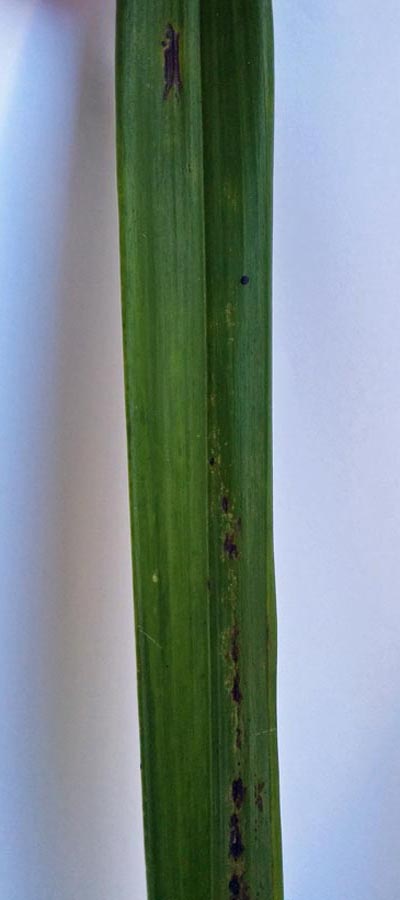
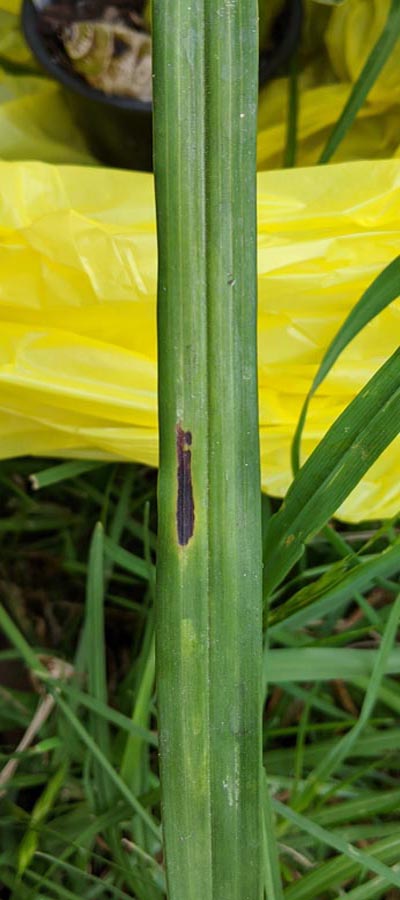
I have never seen rings or circular necrotic patterns in Cymbidiums that were confirmed to result from ORSV, so do not expect them just because of the name of the virus. Most of the confirmed infections I have seen show a mix of chlorotic markings (lighter green-yellow patches on the leaves, sometimes in the shape of a “V” which Inouye (1966) describes as a “diamond mottle”) and necrotic lines (dead, black or brown tissue). Intriguingly, the placement of the necrotic lines has been quite consistent and I suspect may be a good visual indicator of ORSV – necrosis occurs as patches or solid bands down the middle of one or both halves of the leaf (not down the middle fold of the leaf, nor on the edges of the leaf, as shown in the above photos).
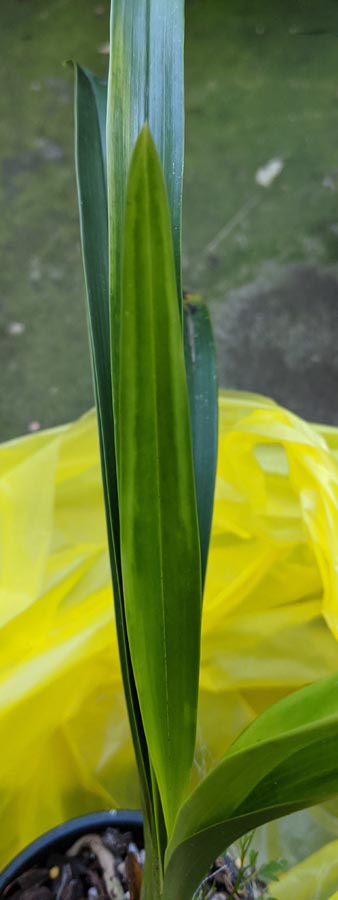
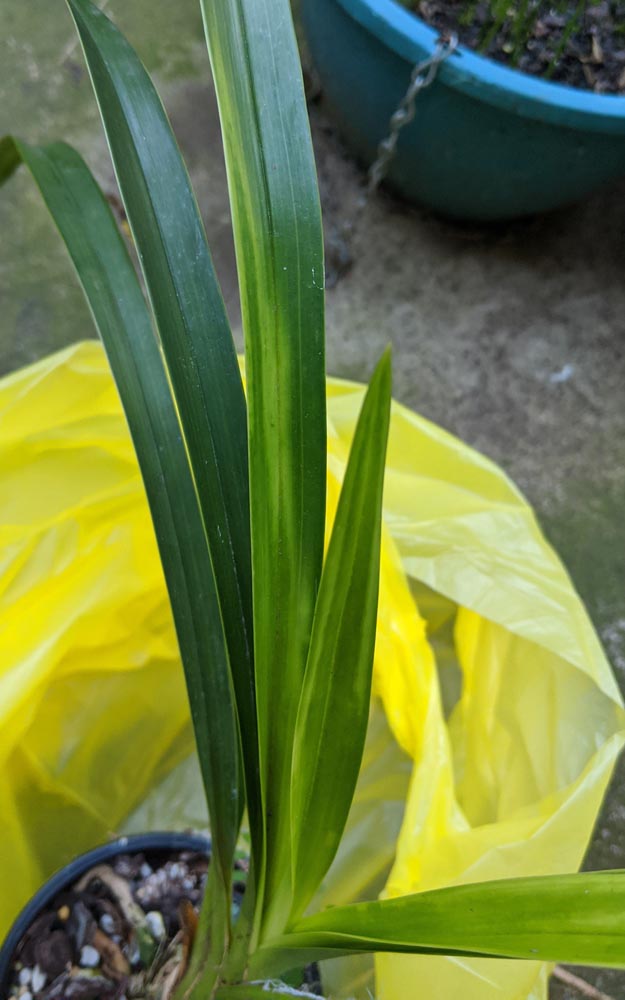

In some cases (especially seedlings or clones that are infected early on), the new growth can manifest chlorotic streaks like that shown in the photos above. As you can see, it was about to be bagged and binned when I took the photos.
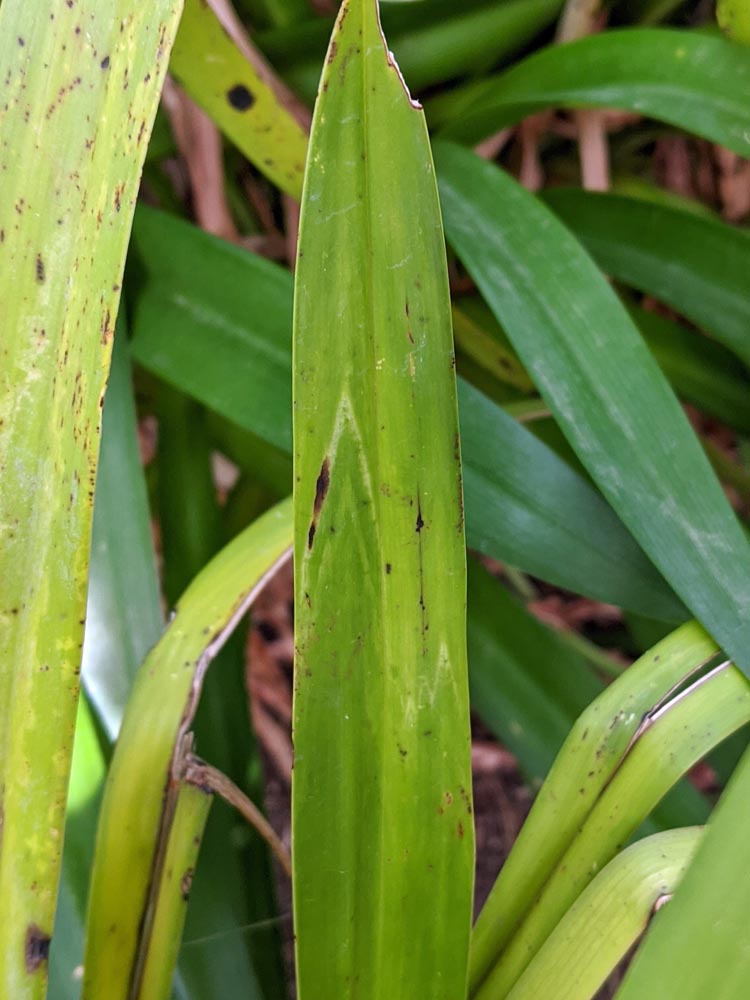
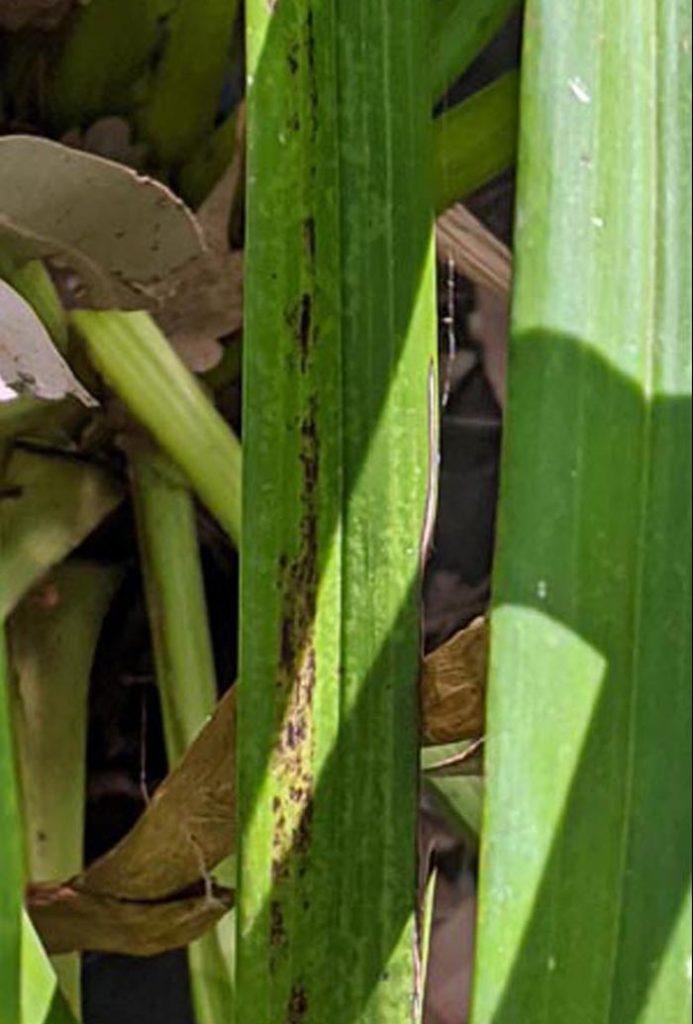

I have only seen the aforementioned “V” chlorotic mark once (above left). The middle photo shows a single symptomatic leaf on a different plant that tested positive for ORSV. Nado Lenkic (of Springfield Orchids, Western Australia) kindly provided the above right photo of ORSV symptoms showing more circular chlorotic markings. In my experience, this is not common, but can occur.
Orchid Fleck Virus (OFV)
Relatively speaking, OFV is the new kid on the block, despite having first been identified in Cymbidiums in the 1970s. Its spread across the globe and through many Orchid genera seems to have been caused by poor lab practices (cloning of virus mother plants), particularly in Southeast Asia, and it has become a significant problem in Australia over the past couple of decades. Some growers consider it to be the worst of the three main viruses.
When this Cymbidium orchid virus was analysed in the early 2000’s, it was found to be different enough to all known Rhabdoviruses such that it required its own genus – Dichorhavirus (initially Dichorhabdovirus) in the family Rhabdoviridae. Much of the research on this virus has happened in the 21st century; thanks to the support of the Cymbidium Orchid Club of South Australia, Raymond Ali at the University of Tasmania studied OFV and its vectors (Wilson & Ali 2013). As a result, the Department of Natural Resources and Environment (NRE) Tasmania includes a test for OFV in its Orchid virus test regime.
Like CymMV and ORSV, OFV is mechanically transmissible. Brevipalpus californicus, a type of false spider mite or flat mite, appears to be the primary natural vector (Peng et al. 2013; Kubo et al. 2009) and the mites remain capable of infecting plants “for a long period.” This sustained infectivity makes pest control critical to prevent the spread of OFV within a collection. Additional research indicates that similar pests – Brevipalpus oncidii (Ali et al. 2017), some aphids (Myzus persicae and Aulacorthum solani) and the red spider mite (Tetranychus urticae) (Kondo et al. 2003) – may not be able to act as a vector, fortunately. Brevipalpus yothersi was identified by the Australian Government’s Department of Agriculture, Water and Environment as another vector (Parker, 2021).
OFV is thought to be less contagious than CymMV and ORSV
This is partially due to its narrow optimum temperature range. It is most successful at infecting a new host at 30°C or higher (Chang et al. 1976), although can still transfer at lower temperatures and has a thermal inactivation point of ~45°C (Peng et al. 2013). I was unable to find any research into whether this Cymbidium orchid virus could transfer via pollen or seed. Thankfully, OFV is short-lived outside a host, lasting only a matter of hours.
More troubling, though, is the fact that OFV can infect non-Orchid plants (Kondo et al. 2003; Kubo et al. 2009), such as some members of Chenopodiaceae (the Goosefoot family, now part of Amaranthaceae), Solanaceae (the Nightshade or Potato family), Leguminosae (the Legume, Pea or Bean Family) and Aizoaceae (the Carpetweed family). How long the virus persists in these plants is not known, but it is advisable to maintain good pest control in the garden in order to prevent OFV establishing a reservoir from which it can reinfect your orchid collection.
Critically, OFV has recently been identified to infect members of the Citrus genus within the Rutaceae family (Parker 2021). Citrus leprosis has been known since the 1900s, but there has been a significant resurgence in Latin America in the past few decades. Until recently, three different viruses had been associated with the condition: Citrus leprosis virus nuclear type (CiLV-N), Citrus leprosis virus cytoplasmic type (CiLV-C) and Citrus leprosis virus cytoplasmic type 2 (CiLV-C2).
In 2013, the genome of CiLV-N was analysed, and it was determined to be closely related to OFV – so much so that it was proposed as the second member of the Dichorhavirus genus (Roy et al. 2013). Additional research published identified two citrus strains of OFV (OFV-Cit1 and OFV-Cit2, both distinct from CiLV-N) and compared them to the two known strains infecting orchids (OFV-Orc1, the original Orchid Fleck Virus, and OFV-Orc2), allowing the construction of a phylogenetic tree illustrating the relationships between the viruses (Roy et al. 2020).

Phylogenetic relationships among dichorhaviruses infecting citrus, orchids, coffee and the genus Clerodendrum, based on the nucleotide sequences of the two genome segments (RNA1 and RNA2). CiCSV = citrus chlorotic spot virus; ClCSV = Clerodendrum chlorotic spot virus; CoRSV = coffee ringspot virus. Taken from Roy et al. 2020.
The analysis indicated that the citrus strains of OFV very likely descend from the original orchid strain and that all the OFV strains share a common ancestor with CiLV-N. Further analysis carried out by Roy et al. found that OFV-Orc1 was also present in at least one citrus sample and that both citrus strains were widespread in citrus in Mexico. Pest Advisory No. 20-02 published by the Department of Agriculture in Hawaii in July 2020 reported the infection of lemon and mandarin trees by OFV-Orc2. Additionally, spill over from orchids to citrus has been theorised as the most likely cause of an OFV variant found in orange orchards in South Africa (Cook et al. 2019), highlighting the risk that infected orchids present to citrus and vice versa.
Given these recent findings, I would encourage anyone growing citrus and/or orchids to be vigilant about pests (particularly mites). Check your citrus plants for any signs of citrus leprosis, as well as take appropriate hygiene measures to avoid introducing OFV to from infected fruit you may obtain.
Unfortunately the exact amount of time required for OFV to become systemic (and therefore reliably detectable) is unknown. An incubation period of 2-3 weeks was recorded for Dendrobiums, although anecdotal evidence from some Victorian growers suggests Cymbidiums may not show symptoms until the next growth cycle. The symptoms of OFV vary depending on the host genus. For Cymbidium Orchids, potential symptoms include concentric oval-shaped necrotic flecking patterns or cross-crossing lines along the leaves (Kim et al. 2010). Chlorotic blotching can also be present and under the right conditions, the plant can be completely asymptomatic.
Below is a photo of a confirmed OFV infection (one of the few occasions I have actually seen symptoms).

Once again, Nado Lenkic has provided additional examples of OFV symptoms for reference:
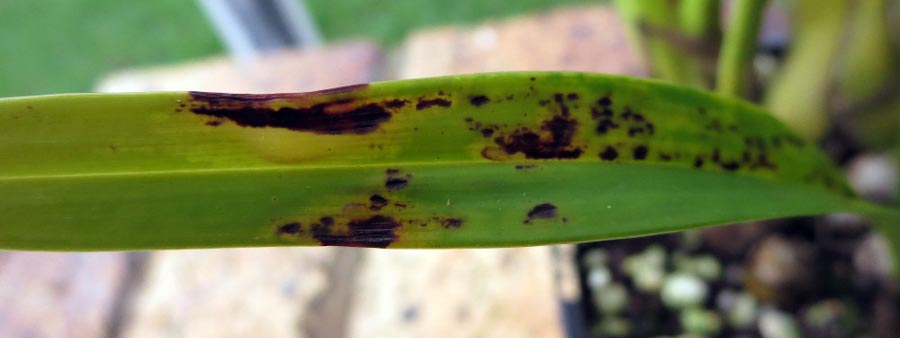
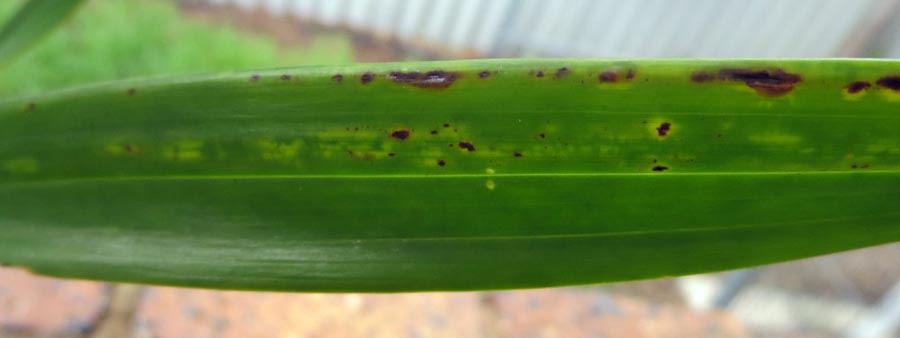




My own personal experience with OFV leads me to suspect that this Cymbidium orchid virus can be present in very low levels and produce a false negative test result under the right conditions. I obtained three Cymbidium backbulbs from a historic plant and potted up them together. All three struck successfully. For the first 6 months or so they were kept with other plants from the same source. They were then isolated after I noted suspicious markings on one of the other plants in the group. About 18-24 months after they produced the initial growth, I finally got around to sending samples off to DNRET.
Now, you might wonder what the point was – all three were from the same parent plant, shared the same pot and were asymptomatic, so surely one sample would have been enough. As I am very cautious about Cymbidium orchid virus and didn’t want to take any chances, I sent a sample from all three. I am glad I did, as only one of the three returned a positive result for OFV (and DNRET noted that it was a low level). I consider it practically impossible that only one of the three plants in the pot had been infected for several reasons – I never noted any pests or pest damage; the pot had been isolated for over 12 months (ample time for any infection that might have been introduced to spread amongst the three) and I had no other known OFV cases in my collection or quarantine areas. I theorise that had I reduced the quality of care and allowed the virus to multiply, the other two plants would later have tested positive.
Multiple Infections
An important point to note is that it is quite possible for an orchid to be host to more than one Cymbidium orchid virus. Pearson & Cole (1986) infected plants with both CymMV and ORSV during their study, whilst I have only seen a plant with multiple viruses once. I suspect that the presence of more than one Cymbidium orchid virus would result in a terminal decline of the plant. Symptoms may match those of the individual viruses, or they may differ due to the combined effects of the viruses. An example of a symptomatic plant infected with both OFV and ORSV is shown below.

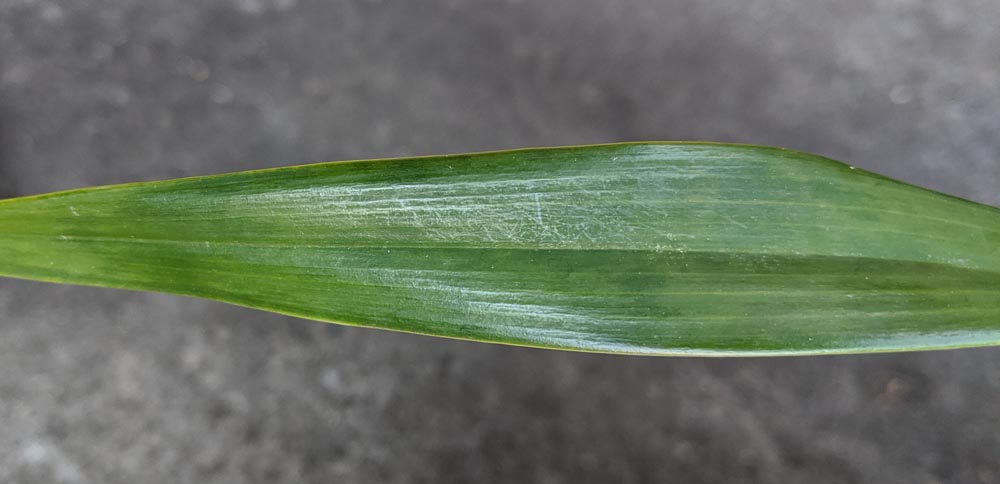

Disconcertingly, even with multiple Cymbidium orchid virus infections, a plant can be asymptomatic when well-grown. In 2021 I acquired three plants, all beautifully grown, from a local grower. Of the three, two were virused (shown right) – the smaller of the two had ORSV (with only one leaf showing a tell-tale linear marking, which was small enough that I missed it initially). The larger of the two had both ORSV and CymMV and yet had perfectly clean foliage! The poor grower was horrified when I shared the results and I don’t think they were even aware that they could have Cymbidium orchid virus in their collection.
Please be aware that your plant does not have to show leaf markings for it to be virused! As mentioned earlier in this article, always sterilise your tools and change your gloves or wash your hands after working on each plant. Test anything that looks suspicious and be prepared to destroy infected plants. Finally, if you have a plant showing viral symptoms, please DO NOT exhibit it, as it can pose a risk to other growers’ plants.

Conclusion
If there is one thing I would like the reader to take away from this article, it is that they should not rely on visual symptoms being present before suspecting a Cymbidium orchid virus infection – always act as though there might be a virus in your collection. All three viruses can be asymptomatic or vary significantly in the degree of symptoms displayed. That said, I encourage the reader not to ignore any markings that resemble the photos included in this article; if there is any possibility it is virused, please get the plant tested.
References
Ali, R.N. et al., 2017. Brevipalpus oncidii, a new record for Australia, is not a vector of Orchid fleck virus. International Journal of Acarology, 43(1), pp.44–51. Available at: http://dx.doi.org/10.1080/01647954.2016.1232310.
Allen, C., 2010. Virus Transmission in Orchids through the feeding damage of the Australian cockroach, Periplaneta Australasiae. Acta Horticulturae, (878), pp.375–379. Available at: http://dx.doi.org/10.17660/actahortic.2010.878.47.
Allen, C.D., 2012. Transmission of Cymbidium Mosaic Virus in Oncidium Orchids by Periplaneta australasiae. Masters in Science. Faculty of the Graduate School of the University of Maryland, College Park. Available at: https://drum.lib.umd.edu/bitstream/handle/1903/13664/Allen_umd_0117N_13659.pdf.
American Air and Water, UV Irradiation Dosage Table. American Air and Water. Available at: https://www.americanairandwater.com/uv-facts/uv-dosage.htm [Accessed April 20, 2019].
Chang, M. et al., 1976. Morphology and Intracellular Appearance of Orchid Fleck Virus. Ann. Phytopath. Soc. Japan, 42, pp.156–167. Available at: https://www.jstage.jst.go.jp/article/jjphytopath1918/42/2/42_2_156/_pdf.
Cook, G. et al., 2019. Orchid fleck virus associated with the first case of citrus leprosis-N in South Africa. European Journal of Plant Pathology, 155(4), pp.1373–1379. Available at: http://dx.doi.org/10.1007/s10658-019-01854-4.
Coutts, B.A., Kehoe, M.A. & Jones, R.A.C., 2013. Zucchini yellow mosaic virus: Contact Transmission, Stability on Surfaces, and Inactivation with Disinfectants. Plant disease, 97(6), pp.765–771. Available at: https://doi.org/10.1094/PDIS-08-12-0769-RE.
Freitas-Astúa, J. Virus. Originally published in the September 2003 issue of Orchids – The Bulletin of the American Orchid Society. Available at: https://www.aos.org/orchids/orchid-pests-diseases/virus.aspx
Gibbs, A., 1999. Evolution and origins of tobamoviruses. Philosophical transactions of the Royal Society of London. Series B, Biological sciences, 354(1383), pp.593–602. Available at: https://royalsocietypublishing.org/doi/10.1098/rstb.1999.0411.
Hamilton, R.I. & Valentine, B., 1984. Infection of orchid pollen by odontoglossum ringspot and cymbidium mosaic viruses. Canadian journal of plant pathology. Revue Canadienne de phytopathologie, 6(3), pp.185–190. Available at: https://doi.org/10.1080/07060668409501548.
Hu, I.S., 1994. Transmission, Movement, and Inactivation of Cymbidium Mosaic and Odontoglossum Ringspot Viruses. Plant Disease, 78(6), p.633. Available at: https://dx.doi.org/10.1094/pd-78-0633.
Inouye, N., 1966. A Virus Disease of Cymbidium Caused by Odontoglossum Ringspot Virus. Reports from the Ōhara Institute of Agricultural Biology, Okayama University, 13(3). Available at: http://ousar.lib.okayama-u.ac.jp/files/public/4/49987/2016052809564197652/boi_013_003_149_159.pdf.
Kim, S.-R. et al., 2010. Molecular Characterization and Survey of the Infection Rate of Orchid fleck virus in Commercial Orchids. The Plant Pathology Journal, 26(2), pp.130–138. Available at: https://dx.doi.org/10.5423/ppj.2010.26.2.130
Koh, K.W., Lu, H.-C. & Chan, M.-T., 2014. Virus resistance in orchids. Plant science: an international journal of experimental plant biology, 228, pp.26–38. Available at: https://doi.org/10.1016/j.plantsci.2014.04.015.
Kondo, H., Maeda, T. & Tamada, T., 2003. Orchid fleck virus: Brevipalpus californicus mite transmission, biological properties and genome structure. Experimental & applied acarology, 30(1-3), pp.215–223. Available at: https://doi.org/10.1023/b:appa.0000006550.88615.10.
Kondo, H. et al., 2006. Orchid fleck virus is a rhabdovirus with an unusual bipartite genome. The Journal of general virology, 87(Pt 8), pp.2413–2421. Available at: https://doi.org/10.1099/vir.0.81811-0.
Kubo, K.S. et al., 2009. Orchid fleck symptoms may be caused naturally by two different viruses transmitted by Brevipalpus. Journal of general plant pathology: JGPP, 75(3), pp.250–255. Available at: https://doi.org/10.1007/s10327-009-0167-z.
Moles, M. et al., 2007. Evidence that Cymbidium mosaic virus (CymMV) isolates divide into two subgroups based on nucleotide diversity of coat protein and replicase genes. Archives of virology, 152(4), pp.705–715. Available at: https://doi.org/10.1007/s00705-006-0897-6.
Parker, C., 2021. Biosecurity Advice 2021-P06 – Release of the draft report for the review of biosecurity import requirements for fresh Persian lime fruit from Mexico. [online] Australian Government – Department of Agriculture, Water and the Environment. Available at: https://www.awe.gov.au/biosecurity-trade/policy/risk-analysis/memos/ba2021-p06 [Accessed 12 April 2022].
Paul, H.L. et al., 1965. Untersuchungen am Odontoglossum ringspot Virus, einem Verwandten des Tabakmosaik-Virus: I. Physikalische, chemische, serologische und symptomatologische Befunde (Studies on the Odontoglossum ringspot virus, a relative of the tobacco mosaic virus: I. Physical, chemical, serological and symptomatological findings). Zeitschrift für Vererbungslehre, 97(2), pp.186–203. Available at: https://doi.org/10.1007/BF00897495.
Pearson, M.N. & Cole, J.S., 1986. The Effects of Cymbidium Mosaic Virus and Odontoglossum Ringspot Virus on the Growth of Cymbidium Orchids. Journal of Phytopathology, 117(3), pp.193–197. Available at: https://dx.doi.org/10.1111/j.1439-0434.1986.tb00934.x.
Peng, D.W. et al., 2013. Orchid fleck virus: an unclassified bipartite, negative-sense RNA plant virus. Archives of virology, 158(2), pp.313–323. Available at: https://doi.org/10.1007/s00705-012-1506-5.
Porter, K.G., Kuehnle, A.R. & Hu, J.S., 1996. Lack of seed transmission of cymbidium mosaic virus in Dendrobium. Lindleyana: the scientific journal of the American Orchid Society, 11(4), pp.211–213.
Roy, A. et al., 2013. Genome assembly of citrus leprosis virus nuclear type reveals a close association with orchid fleck virus. Genome announcements, 1(4). Available at: http://dx.doi.org/10.1128/genomeA.00519-13.
Roy, A. et al., 2020. Reassortment of Genome Segments Creates Stable Lineages Among Strains of Orchid Fleck Virus Infecting Citrus in Mexico. Phytopathology, 110(1), pp.106–120. Available at: https://doi.org/10.1094/PHYTO-07-19-0253-FI.
Wilson, C.R. & Ali, R., 2013. Improved detection of Orchid Fleck Virus and other important Orchid viruses and a new Brevipalpus mite vector, University of Tasmania.
Copyright and Reuse
Circular ORSV Markings Photo and the Circular and Necrotic OFV Markings Photos Copyright © 2020 Nado Lenkic and used with permission. Regabio Test Kit Photos Copyright © 2020 Andrew Wagstaff and used with permission. All other photos and text Copyright © 2020–2022 Joshua White.
Please contact the author at jwhite88@gmail.com for reuse (i.e. hosting a copy on another website, including in a newsletter or other publication, etc.) or modification. This article may be freely distributed in its original, unedited form. Please feel free to directly link to this article if you would like to.
This article first appeared as a series in Cymbidium Chatter Issues 12 through 15 (published July 2020), with addenda in Issues 17 (August 2020) and 31 (June 2021). The online version was last revised 13th September 2022.
Orchid Wise Society
With over 30 years of experience joining the Orchid Wise Society is a great way to join other cymbidium orchid grower enthusiasts around the world. I promise not to overload your inbox with unnecessary rubbish, instead I pride myself on providing relevant & interesting information with regards to all things Cymbidium orchids.
I welcome your feedback on past mailings and if you have any suggestions for what you would like to see in future ones.
Thanks,
Karl

